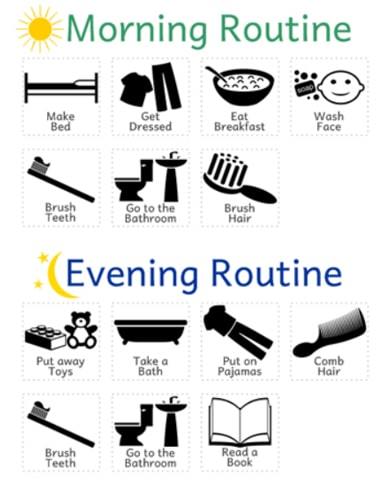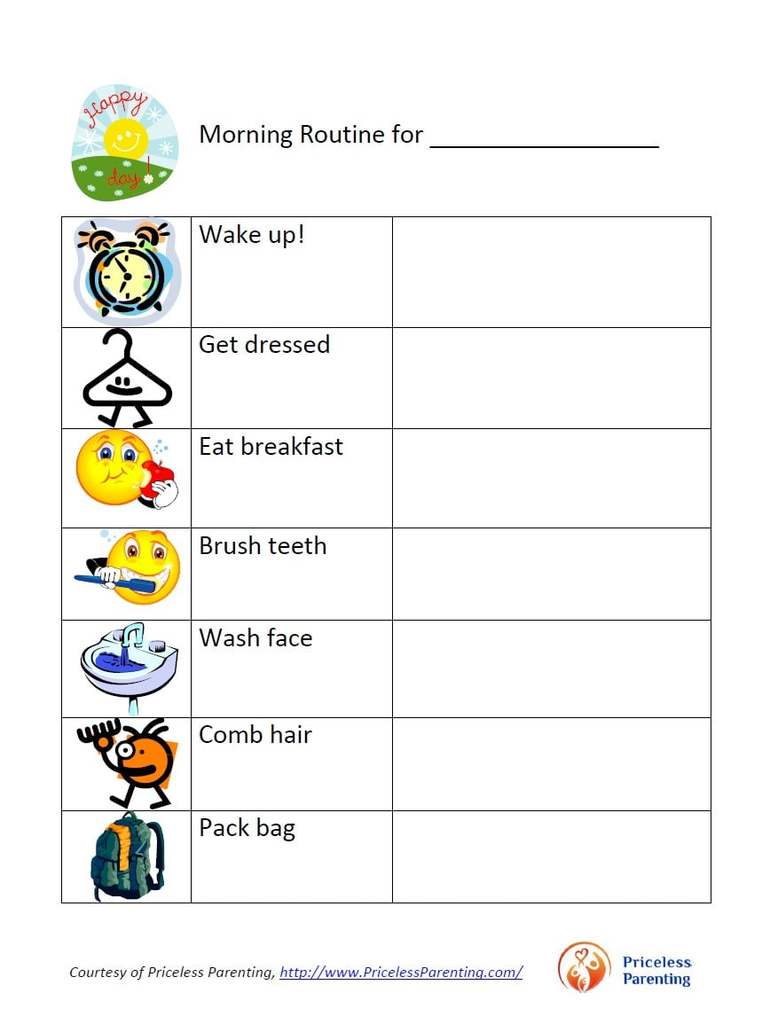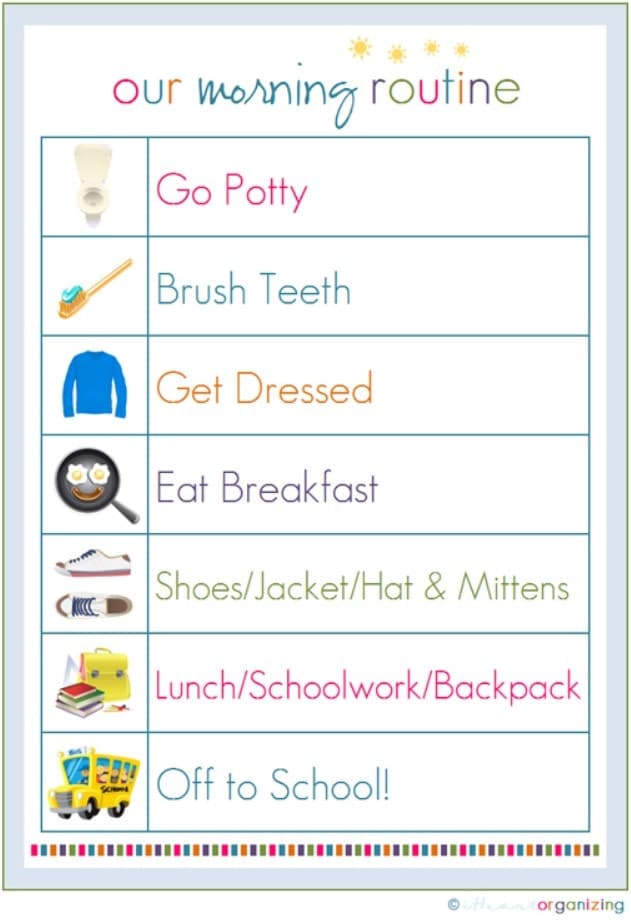There might be affiliate links on this page, which means we get a small commission of anything you buy. As an Amazon Associate we earn from qualifying purchases. Please do your own research before making any online purchase.
If you’re a parent, chances are your mornings can be a bit hectic… not to mention, stressful. But this doesn’t have to be the case.
You have the power to make mornings a bit easier on yourself.
How you ask?
By simply adding a little structure.
No matter what age your child is, you are allowed to make them accountable for certain things each day. It’s your responsibility as a good parent.
Not only will doing so teach them about responsibility and consequence, but it will take a little bit off your parenting plate.
Why is Morning Routine Important for Kids?
Establishing a morning routine for kids is the perfect way to get kids to contribute. And there are benefits to it as well, such as:
- Creating an increased sense of confidence and independence in your child: Your child will feel good about themselves knowing they can do some of the things you normally would do for them.
- Greater self-control: Your child will learn to appreciate the work/play balance, understanding certain things need to happen before they can have fun and relax
- Stress reduction: By knowing what is expected of them ahead of time, children will often feel less anxiety and worry.
- Teaching them healthy, lifelong habits: While it may seem silly to put items like “take a shower” or “wash your hands” or “make your bed” on a morning routine checklist… it actually works to instill good habits in your kids that they will hopefully carry with them later in life.
- Instills a sense of appreciation for what you do: By assigning your children certain responsibilities, you are guiding them towards a greater sense of appreciation for all that you do. Thus, they will be less likely to take you for granted later in life.
Establishing a morning routine sets a tone for the day.
Depending on the age and personality type of your child, there are a variety of tactics you can choose from when creating a morning routine that works for them specifically.
Keep in mind that every family’s situation is different.
Perhaps you have all toddlers? Tweens? Teens? A mix?
Maybe your spouse travels a lot? Maybe you both work? Maybe you stay at home?
Or, maybe you have a child on the spectrum? Or one that suffers from ADHD, anxiety or OCD?
Regardless of your situation, an established morning routine can make life a bit easier… and that is all any parent is really hoping for.
In this article, I will provide a step by step process on how to create a morning routine for kids that works.
Before we proceed, if you prefer to watch instead of read, here's the Youtube version of this article:
Step #1: Make a list of your daily responsibilities.
Starting with Monday, make a list of everything you typically do on that day. Obviously, unplanned things will sometimes occur; however, just keep this list to customary day-to-day responsibilities.
Things like:
A good rule of thumb is this: if it’s a typical daily chore (aka, a mom/dad thing), or if it’s on your daily or weekly calendar, list it here.
Do the same for the rest of the week.
Once you have the list in front of you, start to check off the morning-relevant items you think your child could handle.
Note: this step would also work for creating after school and weekend routine charts, but we will save that for another article.
If you have more than one child, you may want to create separate columns and list age and behavior appropriate tasks in each. (Use behavior charts as visual reminders.)
Clearly, you wouldn’t include “load dishwasher” on a toddler’s morning routine chart… but a child over the age of 9 could likely handle it (just watch for sharp knives).
You know your child best… so use your judgment when assigning tasks to him or her. This will help to ensure the chart is a positive experience for both of you.
Step #2: Know your audience.
Again, keeping your child’s age and abilities in mind is the key to success when creating a morning routine for kids that works.
The last thing you want is for your child to feel as if a task is daunting… this will only foster resistance on their end, and stress on yours.
For instance, do not ask a kindergarten-aged child to pack their own lunch. Instead, give them the responsibility of packing their snack from an approved snack drawer.
As a mother of four children, ages 4-9, I elected to have two kid-friendly drawers in our house.
One is filled with parent-approved, simple breakfast foods the kids can help themselves to in the morning (ie… granola bars, dry cereal, rolls, raisins). The other contains “safe” school snacks they can choose from.
You also need to keep a balance between the amount of “life skill” items on the list, versus chore items.
Life skill items include things such as:
Chore items are those that will help you out, such as:
There are free printable charts online that cater to different age groups. Some have come up with “to do” items for you, others leave room for customization.
All of them suggest laminating the document after printing so that you can use dry-erase markers or easy-peel stickers. This allows the chart(s) to be reused, cutting down on waste of paper and printer ink.
For smaller children who can’t yet read, charts with pictures seem to work well.
Here are some of the better ones I came across:
Picture Centric Chore Chart: This one is meant to be circled… think routine chart meets an art project.

Hybrid Chore Chart : Clip art pics and words make it easy for little tykes to follow.

Juvenile Chore Chart: This one made the smaller children list for use of the word “potty”, but it could also probably work for kids under 6.

Step #3: Give the routine purpose.
Categorizing the morning routine chart can help children feel a bit more independent… especially those children between the ages of 6 and 10-years-old (give or take a year on either end).
Categories will also create the illusion of free thought by giving purpose to each task on the chart.
For instance, this free printable is semi-customizable and includes three main categories:
It allows you to place your own tasks in each category, which can be a great point of discussion between you and your child.
You can ask them to come up with items (or choose from a list you made) that they think should go into each section.
This method will give children the opportunity to make a connection between their actions on various aspects of their life.
This printable was probably my favorite for elementary school-aged children.
Honorable mentions include:
- Cut to the chase:
- Colorful and easy to follow:
Step #4: Don’t be too cutesy with older children.
Let’s be realistic if you’re the parent of a tween or teen… you are likely going to face some resistance when you spring a morning routine chart on them.
If not resistance, you’ll definitely witness an eyeball roll or two. Guaranteed.
You see, most kids between the ages of eleven and seventeen typically need to be told what to do.
Unlike younger children who yearn to feel grown-up, this age group actually thinks they are grown up. And that means they need a reality check.
They are living in your house and must do their part. Nothing in life is free.
It’s as simple as that.
Your love, your time, your money… it is all for them. So they need to be conditioned to respect that.
Straight forward, customizable charts typically work best for older kids. They can even hang them in their rooms should they choose.
You can find blank printables online, like this one. This is especially ideal if you have an older child that engages in after school activities.
Each night, you can have a discussion with your child about the next day’s priorities… and assign tasks accordingly. Items such as, “pack your swim bag” or “prep an after school snack” would be a good fit for this type of morning route chart.
As an added bonus, having discussions the night before allows your child to prep some things ahead of time… should they choose to cut down on what needs to be done in the morning?
It also helps eliminate any surprises, which is great for kids who have a tendency to be anxious.
Planning ahead is one way to decrease the stress associated with a fear of being late in the morning.
Another decent chart that I came across was semi customizable, including a few “built-in” routines while leaving room for your own.
Step #5: Consider the “When Then” method to cut back on resistance.
A while back, I did a review on Positive Parenting Solutions… a world renowned online program created to help parents end the power struggle with their children. And there were some really fantastic tips there.
The method that helped me the most was “When Then”.
In a nutshell, “When Then” is simply phrasing a demand you have of your child in a way that keeps it almost “closed ended”.

They may suspect they have a choice in the matter, but they really don’t.
For example, instead of harping on them to clean up their room, you would calmly say, “When you clean your room, then you may watch television for 30 minutes”.
“When Then” is not you telling them to do something now.
Or throwing out empty threats of punishment.
It is you merely stating a fact.
If they want something, then they need to do something. There is no expiration on the conditions.
So how does this apply to a morning routine for kids?
Well, you could think of it as a sort of reward system.
On the top of the chart, write “When you do these things each morning, then you get XX after school”.
XX could be technology time.
It could be a special snack… or their choice for dinner.
Maybe they want to stay up 15 minutes past their bedtime.
Whatever works.
And if they don’t finish all of their morning duties, they simply don’t get the reward.
You’d be surprised at how well this works, given you allot enough time in the morning for your child to get everything on the list done.
In my house, we have an all-day list. Basically, there are things we expect them to do each day before they are allowed free technology time.
Some can be done in the morning, such as making the beds and clearing the table… while others are to be done after school, such as homework and putting laundry away.
My children race through the checklist and haven’t given much resistance since we started it a few months ago.
Sure… that can change. I know this.
But part of being successful at establishing a routine is knowing how to adapt.
This method may not work forever, especially as my children grow and have more homework… activities… etc. For now, though, it’s effective.
[Are you separated from the other parent of your kid(s)? Find out some good ideas to help with your co-parenting trials.]
Step #6: Make it a team effort.
It is human nature to question authority at times.
And when you’re a child, we as parents are the “authority”.
We play a pivotal role in dictating what our kids do, how they dress, what they eat, where they go, who they are friends with.
The list goes on.
So, naturally, there will be times (likely many of them) when our children demand reasons for our actions and our rules.
They will also call us “unfair” more times than we can count.
That is why it is so important to make morning routines appear to be somewhat of a team effort.

Let your child know that you are not merely dictating or delegating, but rather asking them to do their part in managing the house.
And in doing their part, you will have more time to focus on quality time with them… whether that means watching a family movie together or cooking their favorite meal.
Think about it… if you didn’t have to spend an hour each day folding laundry, you’d be able to spend some of that time coaching their recreational basketball team.
You will also be less stressed, which will result in less nagging and yelling.
Contemplate a chart similar to this one that incorporates routines you are each responsible for. This will ensure them you are working together to make mornings run as smoothly as possible.
You may also want to show them your original to-do list (Step #1), so they see just how much you do for them on a regular basis.
Final Thoughts on a Morning Routine for Your Kids
Routines are a part of life.
School, activities/hobbies, work.
The minute you have a child, your routine changes. It changes to center around them.
It is no longer just about making your day run smoothly… but about teaching them the values of contribution, responsibility, and punctuality. You can't help but want to raise successful kids.
It is about making them better people and equipping them for adulthood. For life.
Kids need to feel they are a part of something… and while they may not always like the tasks being asked of them, they will appreciate the discipline in the long run.
And if you're looking for more resources to help parent your kids, be sure to check out these articles:
- 16 Morning Routine Charts to Print and Track Your Habits
- 15 SMART Goals Examples for Kids
- 35 Fun Things to Do When Your Kids Are Bored
Finally, if you want to level up your parenting skills, then check out this resource that will show you how to get your kids to listen WITHOUT yelling, nagging, or losing control.

Nicole Krause has been writing both personally and professionally for over 20 years. She holds a dual B.A. in English and Film Studies. Her work has appeared in some of the country’s top publications, major news outlets, online publications, and blogs. As a happily married (and extremely busy) mother of four… her articles primarily focus on parenting, marriage, family, finance, organization, and product reviews.


